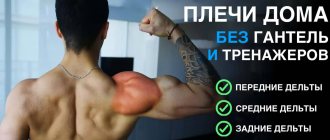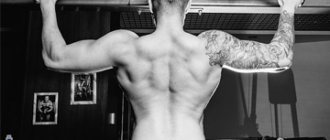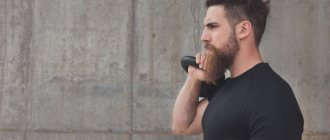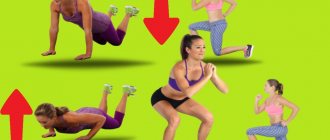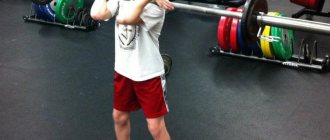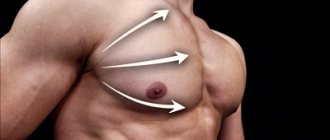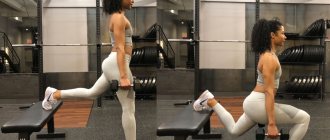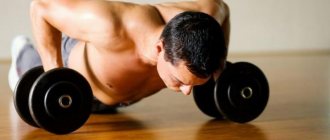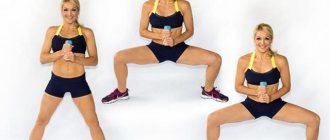In this article, I will show you the most effective workout for building large, wide, strong deltoids and give a set of shoulder exercises at home that can be performed without dumbbells or exercise machines.
In order to pump up your shoulders while working out at home, you need to work out each bundle of deltoid muscles for maximum effect. Often, the anterior and middle deltoids become the target of training, while the posterior deltoids are usually neglected, which is not unacceptable, since one should strive to create a proportional, spherical shape. In a gym setting, working out each area is not so difficult, due to the availability of various exercise machines and equipment that is usually not available at home, which is the main obstacle when training shoulders at home. Therefore, we have selected the most effective shoulder exercises with your own weight without the use of dumbbells and exercise machines.
To pump up your shoulders at home without the use of additional equipment, you need to understand what functions each of the delta beams is responsible for in order to decide on a set of exercises for effective training without iron. Next we will consider:
- Set of exercises
- Correct technique for rapid progress
Why would it be difficult to make your shoulders bigger by training only with your own weight?
Before moving on to describing a set of home exercises, you should warn about the complexity of such a path. Deltas, just like any other muscles, develop effectively if several conditions are met:
- Presence of stress. This means a load that is excessive for the current capabilities of the body, leading to micro-tears of muscle fibers.
- Sufficient rest period. It is during recovery that an increase in body volume occurs, since during the healing process micro-tears are filled with new tissue.
By training only with your own weight, at a certain point your body will completely adapt to the load and muscle growth will stop. It is impossible to increase the intensity of training only by increasing the number of repetitions ad infinitum. In this way, you will move away from building mass towards developing endurance. All that remains is to come up with different variations with the range of motion and resort to supersets (a combination of different types of load without rest between them). But only a professional, and not a beginner practicing on his own, can create a competent training program taking into account such subtleties.
Exercises without weights and in terms of targeting certain areas of the shoulder muscles are limited. The deltoid muscle consists of 3 types of bundles:
- the front one, responsible for moving the arms towards oneself and upward;
- middle (lateral), allowing you to spread your arms to the sides;
- posterior, responsible for abducting the arms behind the back.
Most bodyweight exercises work the front and side deltoids, while the rear deltoids are often neglected.
Training at home makes sense in two cases:
- At the initial stage, when the body is completely untrained. Exercises with your own weight will tone your muscles, teach you to feel your own body and help you pump up a little.
- In the absence of great ambitions, when it is enough to acquire at least some kind of sports form, without building powerful muscles.
It is effective to start your sports journey with home workouts, and when the load is not enough, you can already go to the gym.
Why do you need trained, broad shoulders?
Protects from injury
There is not a single person in this world who does not need shoulder strengthening. Your shoulder is the most mobile joint in your body. And it is also the joint most susceptible to injury. Therefore, it is important that they are strong and stable.
Weak shoulders can lead to all types of muscle and joint injuries. If your shoulders lose strength, other joints can also become injured. This is a kinetic chain effect.
Change your body shape for the better
Well-defined shoulders look great. And broad shoulders are not just for men. They are also important for women. Broad shoulders make a person's figure more athletic. In addition, they are able to highlight some figure flaws.
Help in everyday life
Despite their relatively small size (compared to other muscle groups), they play a huge role. The shoulders are used in every upper body movement. Think about how you use your arms throughout the day, your shoulders act, support and dictate it all.
Therefore, they must be strong and agile, otherwise you will severely limit your movement and ability in any activity involving the upper body.
You use your shoulders every day, almost all day. Any pushing or pulling movement you do with your upper body involves your shoulders. Strengthening them will only make life easier.
Self confidence
This doesn't need any explanation. Everyone is attracted to well-defined shoulders.
Shoulder exercises with body weight
If the goal is to increase the volume of the deltoid muscles, then there is not such a large arsenal of exercises with your own weight. They can be divided into 2 groups:
- various types of push-ups;
- pull-ups and push-ups using a horizontal bar and parallel bars.
In order for all deltoid muscle bundles to develop evenly, a home bodyweight training program should include multidirectional exercises from each of these groups.
Pushups
Classic push-ups work 3 types of muscles - pectoral, triceps and deltoids. But regarding the deltas, we are talking only about the anterior beam, since the middle and rear ones remain unused in this exercise. If your anterior muscle is lagging, then only push-ups while lying down will be enough to solve the problem, otherwise this exercise can only be part of a shoulder training with your own weight.
Technique:
- We take an emphasis lying on straight arms. Place your palms at a distance slightly wider than shoulder width. The feet rest with their toes on the floor, the distance between them is 15-20 cm. The whole body is elongated in an even line.
- We lower ourselves down by bending our elbows until our chest touches the floor.
- Let's go back up.
- Breathing - inhale when lowering, exhale when rising.
We do 4 sets of 15-20 repetitions. In push-ups, it is customary to change the direction of the load by rearranging the hands. So, if you place your arms a little wider, the emphasis shifts to the pectoral muscles, and with a narrow position, the emphasis shifts to the triceps. However, such manipulations have virtually no effect on the effectiveness of pumping the deltoid muscles, so you can stick to the classic version.
Ball push-ups
After the body adapts to the load from classic push-ups, you can move on to more complicated versions of this exercise. For example, use a medicine ball (medicine ball) in it.
Technique:
- The starting position is a classic prone position, only the hands are placed not on the floor, but on the ball.
- Balancing on the ball, we slowly lower ourselves down and then rise back up.
In such push-ups, due to the narrow placement of the arms, the emphasis is on the triceps. But instability of the support significantly increases the load on all muscle groups involved in this basic exercise, including the anterior deltoids.
Elevated leg push-ups
Another way to make push-ups harder is to place your feet higher than the front of your body.
Technique:
- The starting position is the same as in classic push-ups, only we place our legs on an elevated platform. To do this, you can use a step platform, a bench, or any homemade means.
- Slowly lower yourself down, trying to bring your chest as close as possible to the floor, then rise back.
- We carefully monitor the position of the body. It should stretch into a straight line without bending in the lower back, both inward and outward.
The higher the elevation, the more we load our arms and shoulders. You can start by positioning your body to the floor at an angle of 35-40 degrees (when lowering to the lowest point). In the future, you should increasingly increase the load by increasing the angle of inclination.
Wall rack push-ups
Handstand push-ups are a logical continuation of the previous exercise. In a vertical position, we remove the load from the pectoral muscles, directing it as much as possible to the arms and shoulders. Moreover, unlike horizontal push-ups, in this case all bundles of the deltoid muscle are involved.
Technique:
- We stand opposite the wall at a distance of 1.5-2 meters. Then we take an energetic step forward, place our hands on the floor and, due to inertia, throw our legs up. The distance between the hands and the wall should be 10-15 cm, and between the palms a little more than shoulder width. Keep your legs straight.
- Slowly lower yourself down by bending your elbow joints, bringing your head closer to the floor. We do not lower our head to the floor completely, so as not to create a compressive load on the spine and to avoid injury from a sharp blow.
- We also slowly rise back.
The exercise is complex, and you can move on to it only after mastering simpler methods of push-ups. Moreover, it is better to start with half-push-ups with an incomplete amplitude until your arms are sufficiently strong. The number of repetitions should gradually be increased to 10-15 in 2-3 approaches.
Dips
Just as in the case of the prone position, dips on the uneven bars engage only the front delta. But the more varied exercises you include in your training program, the more stress your muscles will experience, thereby accelerating their transformation. Therefore, the bars should not be neglected.
Technique:
- We take the starting position, placing the body perpendicular to the bars. Arms are straightened, legs are crossed.
- As you inhale, move your body forward, slowly bending your elbow joints.
- As soon as you feel a slight burning sensation in the pectoral muscles, we stop for a couple of seconds, after which we return to the original position.
- We repeat the movement 10-12 times, and so on for 3-4 approaches.
It is important to choose the correct width of the beams. It should not be much wider than the width of the shoulders, otherwise it creates a dangerous load on the joints.
Classic pull-ups
There is a horizontal bar in almost every yard, so everyone can afford to include exercises on it in their training program. In the classic version, pull-ups load the front deltoids.
Technique:
- We hang on the crossbar with straight arms. We bend our back at the lower back, cross our legs. The palms are located away from you, the distance between them corresponds to the width of the shoulders.
- As you exhale, slowly pull yourself up until your chest touches the horizontal bar. At the top point your face should be above the bar.
- We lower ourselves down, inhaling.
- We repeat the movement 15-20 times. We do 3-4 approaches in total.
If you perform the same exercise with a reverse grip (palms facing you), the rear deltas will be activated.
Australian pull-ups
Not everyone can immediately start doing pull-ups using the classic method. Therefore, you can start with lighter horizontal pull-ups, or, as they are also called, Australian pull-ups. To perform them you will need a low horizontal bar. In the hall it can be replaced with a bar located on racks.
Technique:
- We hang on a low horizontal bar, stretching our legs forward until the body is completely straightened. In this case, an acute angle should form between you and the floor. We place our palms as wide as possible in order to maximally direct the load on the rear delts, and not on the back.
- As you exhale, pull your chest toward the horizontal bar, bringing your shoulder blades together.
- As we inhale, we go back.
- We do 15-20 repetitions in 3-4 approaches.
When performing the exercise, it is important to bring your shoulder blades together completely. If you do not have time to do this before touching the bar, you need to move your legs forward a little more.
What exercises to do for the muscles of the forearms with your own weight
To achieve the fastest and maximum growth of muscle tissue in the forearms, work with your own weight will need to be organized according to the following recommendations:
• Be sure to accompany your workouts with a warm-up, starting with stretching. To do this, make rotational movements in the shoulder, elbow and wrist joints, as well as bend and straighten them; • Combine sports exercises for the forearms with training for key and large muscle groups. More extensive training will speed up and improve progress from classes; • Perform the exercises as slowly as possible and without jerking - this pace will ensure the best results; • During the training period, organize your diet correctly. Eating a balanced diet with enough protein will help speed up the growth of muscle mass; • Don't forget about rest as well, as muscles always need time to recover after a workout. Although the training regimen is for the most part an individual process, the best option would be to give yourself a day of rest after two days of training, and also alternate days by day the load on different muscle groups. But if you suddenly experience prolonged painful reactions to intense training, you should definitely reduce their frequency and consult a doctor.
Finding the Most Effective Bodyweight Exercises
For men that will help you develop forearm muscles, we, with the help of the Non-Lazy Sloth, have highlighted the following:
• Hanging on one arm; • Passage along the rukolaz; • Pull-ups with a regular grip; • Pull-ups with a narrow grip; • Push-ups from the crossbar while standing at an incline.
Using this selection of exercises, you can effectively pump up your forearm muscles, provided you follow the above tips and recommendations. We have also prepared animations and photos of exercises, with which you can clearly see how the exercise technique works.
Exercises without stress on the spine using a 70-75 degree bench
In many sports exercises, the load is directly or indirectly placed on the spine. This can be harmful for people with back pain, as well as for teenagers whose skeleton has not yet fully formed. These are mainly exercises with free weights in a standing or sitting position without support. Many of them are easy enough to secure using a bench with an adjustable backrest. The angle of the backrest to the floor should be 70-75 degrees. Let's consider options for shoulder exercises from this position.
Seated barbell press
The seated barbell press allows you to pump up your front deltoids.
Technique:
- We hold the bar with a straight grip at chest level. Shoulders straightened. With a narrow position of the arms, only the front deltas are involved, and with a wide position, the middle beam is involved in the work.
- As you exhale, straighten your arms, lifting the barbell up.
- As you inhale, slowly return the projectile to its original position.
- We do 10-12 repetitions in 3 sets.
If the weight is incorrectly selected, the exercise can cause injury to the shoulder joint. Therefore, at first it is important not to overestimate your own capabilities.
Smith machine barbell press
The exercise is similar to the previous one, but is safer for the joints due to the movement of the bar along the guides. In addition, when exercising in a Smith machine, there is no need to control the balance of the barbell, which eliminates the stabilizer muscles from the work, making the exercise more isolated.
Exercises with dumbbells
While sitting on a bench, you can perform 3 types of exercises with dumbbells:
- bench press;
- breeding;
- rise in front of you.
The seated dumbbell press loads the front and side muscles. To perform it, arms with dumbbells are spread to the sides and bent at the elbows at a right angle. As you exhale, the projectiles rise upward until your arms are fully straightened, and as you inhale, they return to their original position.
To perform arm raises with dumbbells, you must not sit down on the bench, but lie down on your stomach. In this case, your arms, slightly bent at the elbows, should hang on both sides of the back. As you exhale, slowly raise your arms up through your sides until your shoulders are parallel to the floor. As you inhale, lower back. The exercise involves the rear deltas.
Raising dumbbells in front of you allows you to work your front and middle deltoids. The movements are performed with slightly bent elbows so that the load falls exclusively on the shoulders. As we exhale, we raise our arms no higher than the level of the chin, after which we slowly return them back. The movement can be performed with both hands at once with a distance between them equal to shoulder width, or alternately.
Anatomy of the muscles of the shoulder girdle
Your shoulders are made up of three main muscles known as the deltoids or deltoids. They are a group of triangular muscles.
- Anterior Deltoids (Anterior)
- Medial Deltoids (Middle)
- Rear Deltoids (Back)
In this article, we'll focus on deltoid exercises because these are the superficial muscles (muscles that can be seen when they're close to the surface of the skin) and are what most people think about when they do a shoulder workout. And they want broad shoulders.
The deltoids are the prime movers, so they will give you the strength and power we want for pushing movements. Moreover, the deltoids are what create the toned, broad shoulders that pop outwardly.
ANTERIOR DELTOID MUSCLES
The anterior deltoid muscles are located on the front surface of the forearm. They attach to your collarbone, allowing you to flex and internally rotate your shoulder joint. Your front deltoids are primarily used when you lift or press your arms in front of you (such as front raises and push-ups).
MEDIAL DELTOID MUSCLES
The medial deltoids are located on the side of the shoulder. They attach to your shoulder blade and are primarily used with exercises that bring your arms to your sides or overhead (such as overhead push-ups and lateral raises).
REAR DELTOID MUSCLES
The posterior deltoids are located on the back of the forearm. They are also attached to your shoulder blade, allowing you to extend and rotate your arm laterally. They also prevent you from leaning forward. The rear deltoids are primarily used in exercises that bring the arms behind the back.
Note: The rear deltoids are the stabilizers of the anterior and middle deltoids under pressure. For example, when you do an upper press, your rear deltoid acts as a stabilizer. The rear delts will be the prime movers during the pulling movements.
ARE THE TRAPEZIS PART OF YOUR SHOULDERS?
The trapezius is a broad, flat, superficial muscle that resembles a trapezius. They extend from the cervical region to the thoracic region on the back of the neck and torso. Although they are not part of your shoulder, they often work during shoulder movements. Back exercises only work the middle trapezius. This is why people often train their shoulders and traps on the same day.
How to combine bodyweight exercises and weight training?
We have already mentioned the low effectiveness of exercise without weights for gaining muscle mass. If you can't go to the gym, you can add a strength component to your program with free weights. To do this, you need to purchase dumbbells or weights, and if this is not possible, replace them with improvised means. For example, load the backpack with something heavy, or sew weights yourself and fill them with sand.
Different types of exercises must be performed sequentially - first we train with weights, then we “finish off” the muscles with pull-ups or push-ups. This program will allow you to work out your muscles better with less time. You can also use the principle of pre-fatigue. By working with your own weight before doing dumbbell exercises, you can get more benefits from your strength training. These types of workouts are high intensity, so before you start, be sure to warm up your muscles well and stretch to eliminate the risk of injury.
Safe load
It is believed that weights that do not exceed our body weight are safe for our muscles. And if working, for example, with a barbell is not for everyone, then the load created by one’s own body is quite comfortable for everyone.
The ability to adapt in response to physical stress is an excellent quality of our muscles. But nature initially provided the ability to control only the weight of your own body. After all, in ancient times, our ancestors ran away from predators, hunted, climbed trees and rocks.
Large bulky muscles, or the ability to lift very heavy objects (bodybuilding and powerlifting) were not a necessity from a survival point of view. Accordingly, our muscular system is not designed for this by default.
Advanced athletes, lifting weights significantly higher than their own weight, achieve these results through long and rigorous training. And beginners who try to rush off the bat get injured and, as a rule, lose interest in the sport.
Therefore, exercises with your own weight are the most natural and safe form of physical activity. They are designed to help everyone, regardless of their level of training, gain good physical shape and a toned figure.
How to speed up progress with sports nutrition?
When it comes to building muscle, nutrition is even more important than the workout itself. Muscles will only grow if you receive enough nutrients, which is not always possible to provide with regular foods. For those who are unable to eat a lot often, sports supplements will come to the rescue. When training for weight, you cannot do without the following products:
Protein. Supplies the body with protein – the main building material. Absorbed 10-15 times faster than regular food. It does not contain excess fats and carbohydrates.
Amino acids. They perform the same functions as protein powder, but are absorbed faster, since the protein is already in a split form.
Creatine. Increases explosive muscle strength.
Omega 3 and 6 fatty acids. Accelerate muscle growth and generally have a positive effect on health.
Vitamin and mineral complexes.
Sports nutrition will only give results if the rest of your diet consists of balanced meals. No matter how useful it is, it is still only an addition to the main diet.
For those who are just deciding whether they need sports nutrition, we recorded a video below:
We recommend: a sports nutrition site with the coolest and most effective assortment!
Programming
Bodyweight training programs are best designed on a circuit basis. That is, it is advisable to work out the whole body in one session. Or divide the load between the lower and upper body. You can complete each session with abs.
Training programs can be created for every day or 4-5 days a week. On each day you can vary the exercises, grips, etc. It is important that the total set of exercises covers the maximum muscle part of your body.
A lightweight bodyweight training program can be used as a morning workout. After all, you perform all the exercises without exercise equipment, and most of them are quite suitable for home use.
Summary
You can tone up your shoulder muscles a little with bodyweight training, but you can only make them truly powerful by adding strength exercises to your program. If you wish, you can actually perform them even at home, and if you have back problems, you can always modify the exercises to a safer technique.
Similar articles
- Shoulder exercises
Read more - The best shoulder exercises for mass
Read more
- Back and shoulders training in one day * Program…
Read more
- Shoulder exercises in the gym are the best...
Read more
- Shoulder exercises in the gym for girls...
Read more
4 33
Did you like the article? Share with friends:
We recommend reading:
Exercises after a shoulder dislocation to strengthen and develop arm muscles
How to pump up your shoulders with push-ups at home?
Shoulder weight training - basics, program and best exercises!
Exercises for shoulder and neck pain – “gymnastics 911” for treating shoulder injuries!
Exercises for the posterior delta of the shoulder: a set of exercises in the gym and at home
Discussion: 4 comments
- King Harlekin says:
Mega respect for promoting weightless training. I have nothing against gyms, but you don’t have to live by them alone) True, there are a little more shoulder exercises in calisthenics, but many are complex and require preparation. Write more programs and exercises for experienced ones and you will become my favorite sports site)) - #39K says:
If you combine shoulder training without weights and with weights, which one should you start with? And how much exercise is best?
- DragonoXneko says:
Cool article. It’s ideal for me because the doctor forbade axial loads, but I need to pump my shoulders somehow. I don’t even do biceps and triceps while standing.
- Max Workout says:
I advise you not to switch to weights later, the muscles will work differently. When I reached the point that all bodyweight exercises were easy, I began using a vest with sand. 15-20 kg and damn hard)
Why do you need to pump up the muscles of the forearms?
When doing everyday activities, the muscles of the forearm are almost constantly used.
Thanks to the help of these muscles, we are able to lift objects and hold them in our hands; they also provide wrist rotation, flexion and extension. Therefore, the stronger a person’s arms, the more weight they can lift and hold. For bodybuilding athletes who make body-strengthening exercises a lifestyle choice, it is especially important to have strong forearms for their training. When your arms are able to hold as much weight as possible in as little time as possible, this creates many options for using a variety of effective exercises for the muscles of the shoulders, biceps, and generally the entire upper half of the body. It should also be taken into account that the muscular system of the forearms is especially actively involved when an athlete performs strength exercises aimed at developing the muscles of the chest and back. Almost all pulling movements are interconnected with the muscles of the forearms. Therefore, if you want to set records in the deadlift, training a powerful grip is simply necessary, which is what exercises using your own weight
to strengthen the muscles of the forearm.
How to train your shoulders
Each of the heads that make up the deltoid muscle must be pumped along with the others equally. This significantly reduces the risk of injury.
- The heads of the muscles differ from each other in the functions for which they are responsible.
- This means that you can’t do it with just one exercise – you’ll have to create a program that includes several exercises for each part of the muscle.
- Here we will offer several possible exercises for each of the beams.
- And you can choose the ones you like the most and combine them with each other.
When training, take a weight that will allow you to work hard at the end of the repetitions, but will not overwork you too much.
Best Shoulder Workout With Light Dumbbells
High reps and short rest periods can always replace heavy weights. This workout is so fast-paced and burn-focused that a strong man could literally do it with mom's dumbbells or maybe even a couple of water bottles.
Another interesting nuance: you don’t even need to get up for this. Sit on the edge of a bench and move from one exercise to another. You'll start with dumbbell curl variations to pre-work your delts, then finish with overhead presses to burn them out.
It won't be too difficult to bench press with light weights in the beginning, but if you return to training when you're already tired, whatever weights you have access to will be more than heavy enough.
Directions
Perform the exercises in a circuit, performing one set of each in sequence with no rest in between. So, you'll do one set of Y-raises and then immediately move on to lateral raises, rear delt flyes, and so on. After this, rest for two minutes and then repeat the circuit again.
Y-lifts
Reps: 10–15
Step 1: Sit on a bench holding a light dumbbell in each hand. Bend your hips so that your torso is at a 45-degree angle, but keep your head, spine and pelvis level.
Step 2: Raise your arms in front of you and slightly to the sides, as if making a Y-shape.
Lateral arm raises
Repetitions: as many as possible
Step 1: Sit up straight with your arms at your sides (you can lean forward slightly if that's easier on your shoulders).
Step 2 Raise your arms 90 degrees with your palms facing down.
Swing your delts back
Repetitions: As many repetitions as possible
Step 1: Lean forward at the hips again as far as possible while keeping your spine long and your lower back flat.
Step 2: Use momentum to lift your arms 90 degrees so you are making a swinging motion. Control your descent and use momentum to begin the next rep.
Pulling back with delts
Repetitions: as many as possible
Step 1: Remaining bent forward, turn your palms inside down.
Step 2: Raise the dumbbells with your elbows outward until your upper back is completely contracted.
Arc Overhead Press
Repetitions: As many repetitions as possible
Step 1: Sit up straight and tighten your core muscles. Raise the weight to shoulder level with your palms facing forward.
Step 2: Press the kettlebells overhead in an arcing motion, just short of your elbows.
Rope pull-up
A very powerful exercise to have in your arsenal. Biceps, triceps, anterior deltoids, middle deltoids, and pectoral muscles are involved. There are 2 types of performing this exercise: using the legs (less effective), without using the legs (very effective).
In custody
With systematic training, the results will not be long in coming. It can be seen within 4 weeks after the start of training. You need to understand that beautiful, pumped up arms take a long, systematic effort.
Knowing some exercises will not help you build beautiful arms.
You need to approach this issue wisely; only this approach will give the desired result. Beautiful hands mean systematic training, nutrition, sleep. Compliance with all the above conditions gives an incredible result. Calisthenicmovement 3 million subscribers
On the middle bun
Dumbbell rows using an incline bench.
- The bench is installed with an inclination of forty-five degrees. You need to lie on it with your back up.
- Dumbbells are held in hands that lower and extend. The wrists are turned from the back to the front.
- You will need to bring your shoulder blades together and point your shoulders back, bending your elbows at a right angle.
- As a result: the shoulders are located on the same plane as the entire body, and the forearms look at the floor, positioned perpendicular to it.
- After completing the action, return to the original position, and then repeat about a dozen times, making 3-5 approaches.
Pulling the projectile to the chin
Grabbing the barbell with a grip about one and a half to two times shoulder width, lift it towards your collarbones, extending your elbows upward.
- By the way, it is this grip that will allow you to maximize the use of the desired part of the muscles, fully activating them throughout the entire exercise.
- Then the barbell is lowered and everything is repeated eight times. Do 3-5 approaches.
Raising and turning dumbbells to the sides
Here's another shoulder exercise with dumbbells. You need to stand up straight, holding dumbbells in both hands and pointing the backs of your wrists towards each other. Now straighten your arms in different directions, gradually turning your hands. Do 3-5 approaches a dozen times.
Side forearm plank
Having assumed a prone position, you need to place one of your hands on your forearm, and place the second palm on your shoulder. Having placed your torso in this position, turn it to the side to reach the plank. In this case, you need to hold the stand on your forearm. And then you can return to the position from which you started.
The exercise is performed as long as you have enough strength. After training one side, immediately begin the other. Do three sets on each arm.
